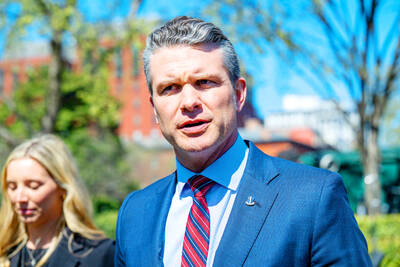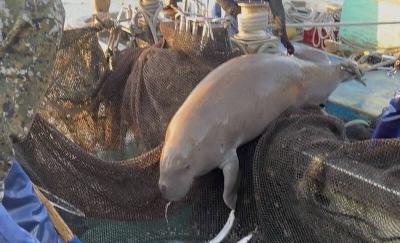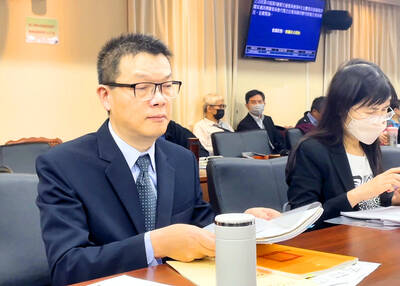The Ministry of Environment would launch satellites in collaboration with the Taiwan Space Agency (TASA) to pinpoint the source and cause of air pollution, Minister of Environment Peng Chi-ming (彭啟明) said.
Authorities can capture real-time data on the ground-level air quality by using 78 monitoring stations nationwide, but they still lack understanding of vertical pollutant distribution in the atmosphere, he said last week.
Environmental monitoring satellites can help assess air quality and detail the distribution of air pollutants, he said.

Photo: CNA
They can also aid carbon reduction efforts by identifying greenhouse gas emission hot spots more accurately than current technologies, he said.
The ministry has proposed a program to integrate satellites and next-generation assessment plans for atmosphere and greenhouse gas monitoring.
Under the program, TASA would develop and launch satellites to observe the distribution of greenhouse gases and air pollution on Earth. The ministry would set up three to four next-generation air quality monitoring stations to obtain real-time analysis of the chemical composition and physical properties of ultrafine suspended particles (PM1).
Analysis results would be combined with data from the Ministry of Health and Welfare to help public health experts with their research, enhance air quality forecast mechanisms and reduce air pollution-related health risks.
The program is projected to run for six years from next year to 2031 with a budget of about NT$6.1 billion (US$186.15 million).
It has been sent to the Executive Yuan for review.
Air pollution and global warming share some emission sources, and ozone and black carbon are critical, the ministry’s Department of Monitoring and Information said.
Currently, the monitoring of greenhouse gases in Taiwan relies on satellite data from the US and South Korea, which are not detailed enough to distinguish between transboundary pollutants and local sources of emissions, it said.
Taiwan’s domestically developed satellites can provide more accurate data, it added.
The ministry has commissioned TASA to develop environmental monitoring satellites equipped with multispectral or hyperspectral instruments which can yield a broad variety of substances, such as PM2.5, carbon dioxide or methane, via optical sensing.
TASA aims to launch the first satellite within three years, with a total of four satellites expected to be manufactured under the program, agency Director-General Wu Jong-shinn (吳宗信) said.
However, low Earth orbit satellites circle the Earth 14 to 15 times per day, a source from TASA said, adding that geosynchronous satellites must conduct monitoring 24/7.
Geosynchronous satellites would remain fixed in the sky if viewed from the Earth, they said.
Such satellites are expected to be developed with an expanded monitoring range to cover all East Asia to better understand how carbon emissions and air pollution in nearby countries such as China would affect Taiwan, Peng said.
Peng said he expects the nation’s environmental monitoring satellites to become the most advanced in Asia.

‘DENIAL DEFENSE’: The US would increase its military presence with uncrewed ships, and submarines, while boosting defense in the Indo-Pacific, a Pete Hegseth memo said The US is reorienting its military strategy to focus primarily on deterring a potential Chinese invasion of Taiwan, a memo signed by US Secretary of Defense Pete Hegseth showed. The memo also called on Taiwan to increase its defense spending. The document, known as the “Interim National Defense Strategic Guidance,” was distributed this month and detailed the national defense plans of US President Donald Trump’s administration, an article in the Washington Post said on Saturday. It outlines how the US can prepare for a potential war with China and defend itself from threats in the “near abroad,” including Greenland and the Panama

The High Prosecutors’ Office yesterday withdrew an appeal against the acquittal of a former bank manager 22 years after his death, marking Taiwan’s first instance of prosecutors rendering posthumous justice to a wrongfully convicted defendant. Chu Ching-en (諸慶恩) — formerly a manager at the Taipei branch of BNP Paribas — was in 1999 accused by Weng Mao-chung (翁茂鍾), then-president of Chia Her Industrial Co, of forging a request for a fixed deposit of US$10 million by I-Hwa Industrial Co, a subsidiary of Chia Her, which was used as collateral. Chu was ruled not guilty in the first trial, but was found guilty

A wild live dugong was found in Taiwan for the first time in 88 years, after it was accidentally caught by a fisher’s net on Tuesday in Yilan County’s Fenniaolin (粉鳥林). This is the first sighting of the species in Taiwan since 1937, having already been considered “extinct” in the country and considered as “vulnerable” by the International Union for Conservation of Nature. A fisher surnamed Chen (陳) went to Fenniaolin to collect the fish in his netting, but instead caught a 3m long, 500kg dugong. The fisher released the animal back into the wild, not realizing it was an endangered species at

DEADLOCK: As the commission is unable to forum a quorum to review license renewal applications, the channel operators are not at fault and can air past their license date The National Communications Commission (NCC) yesterday said that the Public Television Service (PTS) and 36 other television and radio broadcasters could continue airing, despite the commission’s inability to meet a quorum to review their license renewal applications. The licenses of PTS and the other channels are set to expire between this month and June. The National Communications Commission Organization Act (國家通訊傳播委員會組織法) stipulates that the commission must meet the mandated quorum of four to hold a valid meeting. The seven-member commission currently has only three commissioners. “We have informed the channel operators of the progress we have made in reviewing their license renewal applications, and